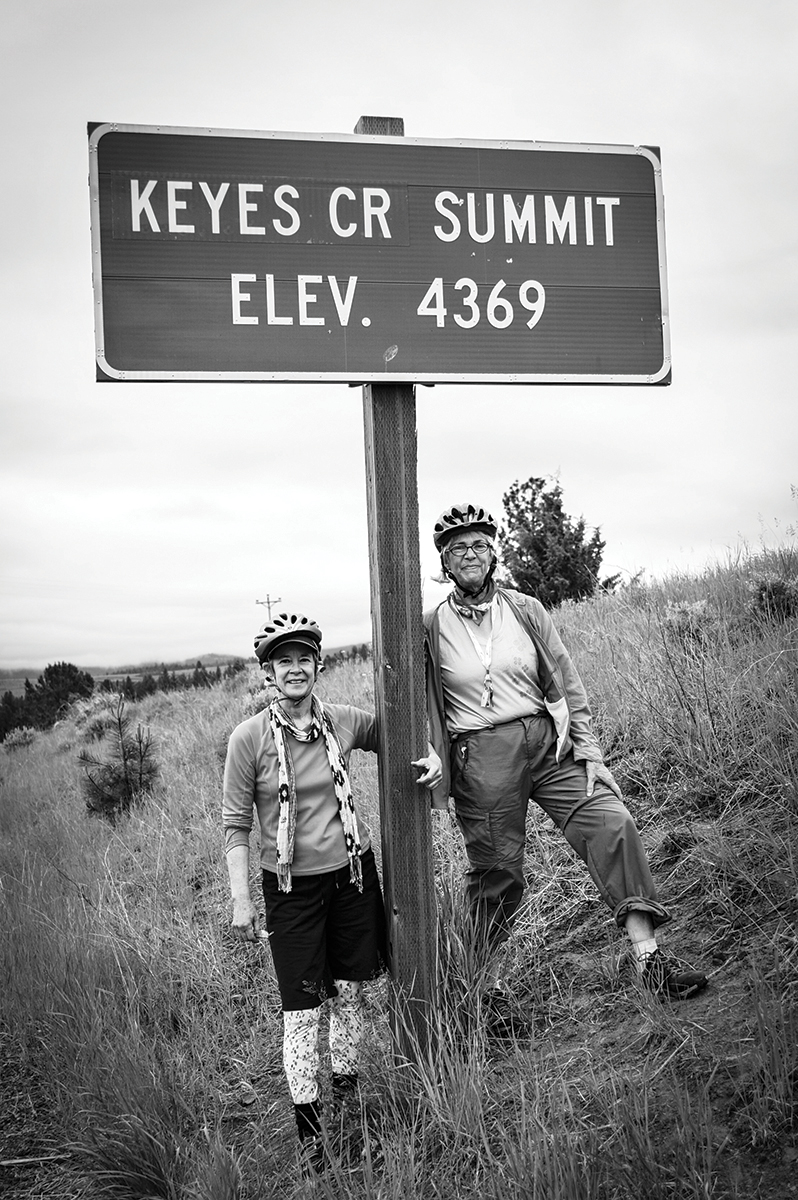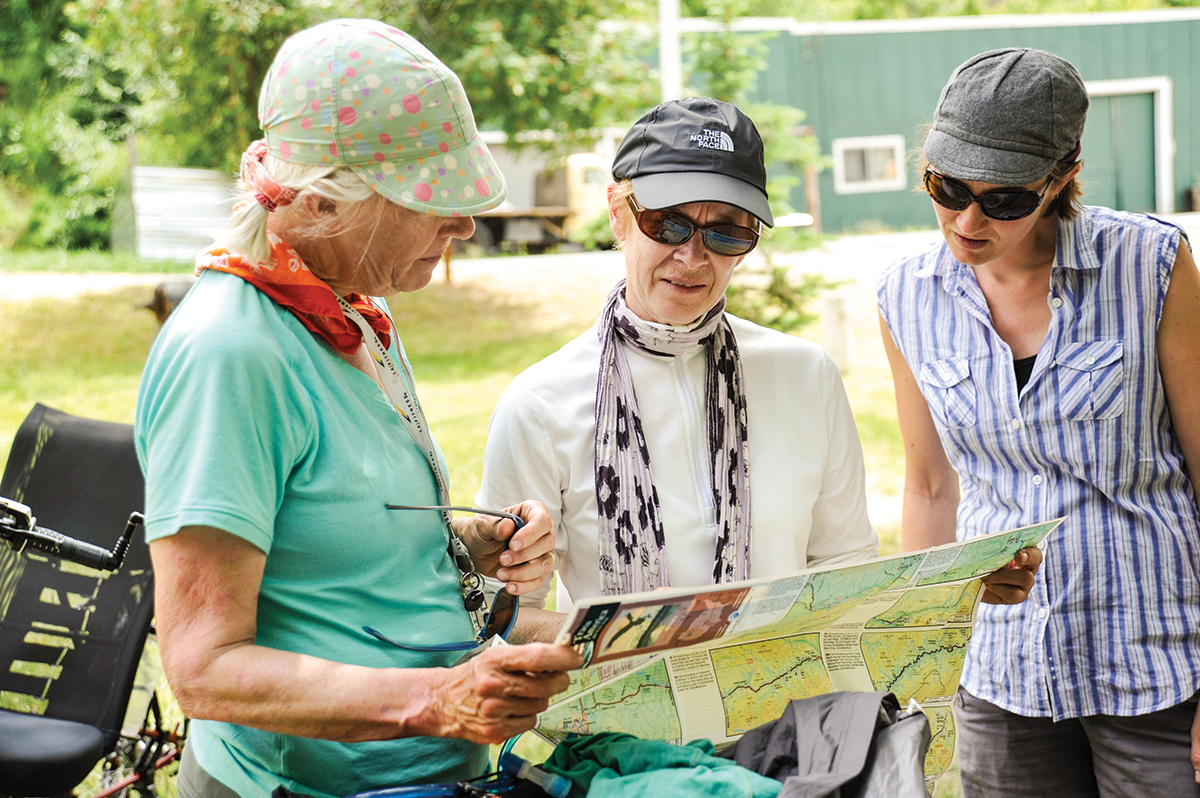The TransAm Granny Method
Seven deadly sins, seven days of creation, seven wonders of the world, seven musical notes, seven years for two white-haired grannies to bicycle the TransAm.
Wait! What?

In April 2011, my lifelong friend Sally Baker Schmidt called me at my home in Annapolis, Maryland, from her home in Portland, Oregon. We’d grown up together in the Philadelphia suburbs but had lived on opposite coasts since our Wisconsin college days. And because I had a head start on Sally in the parenting department, we had been a decade out of sync until about that moment. She sounded … determined. Something was up.
“I need an adventure,” she said. “I’ve been so busy raising kids and teaching that I haven’t had time to do anything really fun and exciting for myself for way too long. Any ideas? Oh, and be careful what you say because I’m feeling pretty antsy, and I’ll do almost anything within reason.”
I didn’t miss a beat. “Let’s bicycle across the country.”
“Um … really?”
“I’ve always dreamed about it, but I never imagined anyone would do it with me.” (Actually, I’d pretty much given up on the idea at that point.)
“Hmm. Do you think that’s a good idea?” she said while most likely remembering crashing our bicycles together when we were 12.
“We can do it,” I said.
“Okay, you’re on,” she said. “Yikes! Did I say that?”
Two months later we were apprehensive owners of recumbent bicycles dubbed Clark and Louie in honor of the explorers whose trail we planned to partially replicate. We hoped riding recumbents would be easier than traditional bicycles on our 62-year-old backs and necks.
I shipped my small, used Easy Racer to Portland. Sally soon discovered Adventure Cycling’s indispensable maps and was eagerly reading up on how best to do this thing. I would most likely have just pointed my bicycle east and headed out to disastrous results. (I’ve never been one for planning. I once got an exam back with a note from the teacher: “Good answer, Patsy. Wrong question.”) It’s wise to select a touring friend with a different skill set.
A Portland bike shop custom designed a special roof rack for Sally’s ultralong RANS recumbent. My less-long bike could fit on the back of her small car, though barely, and not without doing some damage to the hatch. Sally’s husband Art drove us south to Florence, Oregon, on the coast, where the TransAm begins. Our gear, which we’d assembled as best we could figure at short notice, was stashed in panniers and bags. We were bedecked with a variety of lights and flags and as excited as humanly possible. Nevertheless, the fact that this might sound like more fun than it would be in reality be lurked in the back of our minds.
We made it to a campground in Mapleton just 14 miles away. We totally rocked!
That was Day One of Year One, at which point we had no idea if there would even be a Day Two.
As it turned out, we bicycled the TransAm for two to three weeks at a time over seven years, beginning at age 62 and finishing at age 68 (well, 68 and almost 68). Seven hot summers, actually, because Sally still teaches. And we did it slowly. We averaged about five hours and 40 miles per day, six days a week — that’s around 8 mph. Okay, very slowly!
But here’s my point. If we can do it, you (most likely) can do it too! And you should! All you need is desire. Lots of it. And determination in equal amounts. Oh, and a little cash; a good bicycle; a great friend who is more or less as fit — or unfit — as you are; Adventure Cycling maps; a brushup on basic bicycle repair; and a jumbo dose of good luck. But mostly determination because there are going to be times you won’t think this was such a good idea, and you’re going to really have to want it.
It’s going to rain, sleet, and rage with heat. You’re going to have days that never seem to end when your legs are screaming, or days where all three meals are peanut butter sandwiches, or when every bug and critter seems to want a piece of you, or when your eyes are blurry from relentless rumble strips, or when sharing an overflowing toilet with 30 other bicyclists is your only overnight option, or when you underestimate the water you will need, or when your essential prescription sunglasses fall into a storm drain, or when a herd of cattle abandons its cowboy guides in pursuit of you. Like I said, there will be those days, and you have to really want it when those days happen. But if the journey is broken down into two- to three-week segments, it’s all doable.
There would be little satisfaction if all days were like the ones when you ride under cloudless skies, flanked by majestic, snow-capped mountains, accompanied by new, fun friends you’ve met on the road, ending the day by camping in a small-town park after devouring the best pizza you’ve ever eaten (microwaved in the quick-stop freezer section). What gratification is there in forking over big money for a luxury hotel when even the cheapest fleabag can feel like a million bucks after a long day of pedaling? Where’s the fun in dressing for success when you can get the same kick out of catching a glimpse of how ridiculous you look in the fleabag’s mirror wearing gear that you’ve custom created à la Project Runway to match your challenge of the day?
And there’s the laughter. This last summer, Sally asked me, “Do you laugh like this at home?”
Really, not so much. But when you’re as tired and challenged as you will be, everything is funny.
Why is that? For example, I can’t remember a Fourth of July, when not on the bike trip, that we ever videoed ourselves in TransAm Granny gear popping up behind a motel chair to sing “Yankee Doodle Dandy,” certain that we’re incredibly funny, without having at least one glass of wine. There are other more embarrassing times to remember when you’re home and sane, but I’ll spare you. You’ll understand it if you do this trip though. I promise.
I was recently on a flight to Denver to visit my grandkids. A 14-month-old girl threw a four-hour tantrum. Around hour three the parents began to laugh and laugh. It struck me as the same kind of laughter we often experience. Someone upstairs must be looking out for us that we can do this when things get rough.
Having finally reached the Potomac last summer from long ago and faraway Oregon, we now know that desire and determination are the secrets to the universe and the keys to success. We hope to pass this tidbit on to our grandchildren, though we suspect the teenagers may have already figured it out on their own. So bicycling the TransAm at an advanced age is doable. And the many-years approach makes it possible to tackle such a long trip even while staying employed or while in a committed relationship. Breaking the task down into digestible portions and spreading it out to an annual two- to three-week boot camp makes it within reach of those who can’t leave family or job for the time it takes to do it in one three-month gulp.

Now let us chat for a moment about clothing. It’s important, at least to us, to let go of any sense of sartorial pride. Our gear has morphed and been perfected over the years. It’s easy now to spot a TAG from afar because some things are constant.
Most important is that the only bit of a TAG’s skin allowed exposure to the sun is the lower part of the fingers, which are covered liberally with high spf sunscreen. We wear sun gloves at the end of our zip-up thermax turtlenecks. Good, very lightweight turtlenecks are hard to find. My favorites are seven-year-old, very worn EMS Techwicks. They don’t make ’em like they used to, so I forgo stain shame and wear them anyway. I’m hoping the folks at Techwick bring them back. Probably not a big seller, but we miss them.
We completed the TransAm before we reached 70, beating our estimation by two years. Having had the time of our lives, we’ve decided to continue the tradition with an annual east-to-west trip on the Southern Tier. Anticipating this next trip and getting no younger, we got a jump start and began in St. Augustine, Florida, in the spring of 2015, even before finishing the TransAm trip.
Year One we got as far as Tallahassee. Then in 2016 we did Tallahassee to Mandeville, Louisiana. Our white and black bikes for this southern trip are both Tour Easys. “Betty White” and “Shirley Temple Black” are troupers so far. They’re alternately baking and chilling at The Bike Path bicycle shop’s attic in Mandeville. It has been delightful riding on flat terrain with temperate weather for a change. Being in the hot South, we’re doing it on Sally’s spring breaks. (I wish she would retire already, but I guess some kids in Portland still need remedial math so it’s not happening anytime soon.) I’ve spent some non-cycling time writing and illustrating a children’s book, The TransAm Grannies, about our adventure for our grandkids (and yours) to enjoy.
Spring 2018 took us across Louisiana into Texas, and we’ll be at it again in 2019. Come wave at us en route! You’ll know us when you see us.
Advantages of the TransAm Granny method
It requires staying at a basic fitness level throughout the year in order not to suffer too much upon launch. This is a great incentive to go to the gym and walk the dog more often.
Jobs and loved ones need not go without you for three months.
You and your bestie get time together each year.
The cost is spread out over time so as not to shock you all at once, especially if motel rooms and campsites are shared. However, the annual flights and bicycle boarding fees have to be taken into account. We usually pay about $125 per bicycle plus tune-up fee to a bicycle shop for the year — if we can find one. We’ve also left our “boys” in a Good Samaritan’s barn or carted them home in a rental truck when we are close-ish to one coast or the other.
If you choose to spend a bit more time somewhere, or want to take a day off, you can do it.
You needn’t haul extraneous gear for the Rockies while riding through flat, hot Kansas, for example, or cart heavy cooking gear where towns and restaurants are available.
You get to know the wonderful people of our beautiful country. Really, we aren’t so different!
Disadvantages of the TransAm Granny method
You have to get back in shape each year. Week One on the road is hard. Week Two is better. Week Three, you’re in great condition, but then it’s time to park your bicycle and fly home.
A lot of figuring out is required during the last week as you scout out a place to leave the bicycles — preferably near an airport.
Having to stash the bikes and get to an airport can also take one well off route, but surprises are mostly good. Or at least they make for good stories.
TAG Clothing List
This TAG clothing list has been fine tuned over the years. You get the list the easy way and free of charge. I’ve omitted many items we share with generic riders.
- Helmet.
- Visor (admittedly a cap under our helmet — figuring less sun over the years is important, though not recommended by helmet people). I would love to see someone come up with a solution to this. Da Brims only work for flat, slow rides in low wind. For that, they are terrific.
- Sport sunglasses to keep wind out.
- NozKon to keep sun off nose.
- Headband to keep sun off ears.
- “Cheek curtains” — a TAG invention made of cutoff shirt sleeves strung on our glasses frames and tied under our chins.
- Buffs to pull up over our mouths to ward off sun and/or to filter particulates.
- Two of the aforementioned turtlenecks.
- Zip-off pants. Right leg zipped off so it doesn’t snarl in chain.
- Sweatpants for alternate days.
- Light-colored tights to wear under our pants so no sun gets on right leg. Or, white soccer socks — it’s important that they be white when you’re in tick territory so the critters can be easily seen.
- Biking shoes with clips. Sally doesn’t wear these because she doesn’t like being clipped in, but it does help with pedaling.
- Lightweight cotton shirt for feeling more human at dinner.
This story originally appeared in the July 2018 issue of Adventure Cyclist magazine.

